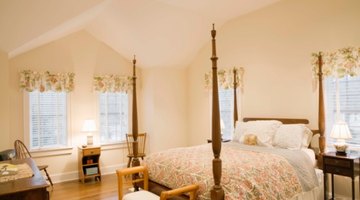What Is a Rice Bed?
Reminiscent of the Old South, a rice bed brings back the elegance and intricate carvings of a forgotten era. A wealthy plantation, plentiful wood, a master craftsman and money combined to create a bed to reflect the style and grace of the antebellum south before its decline.

Although locating an authentic rice bed may be difficult, reproductions are available.
Symbolic Bed Posts
The history of the rice bed originates in 1750, when furniture craftsman Thomas Elfe received a commission to design several pieces of furniture for a wealthy landowner in North Carolina. One of the requested pieces included the rice bed, also known as the Charleston rice bed or a plantation bed. The plantation owner who commissioned the four-poster bed, supposedly required that the symbols of his wealth be intricately carved into the posts of the bed.
Rice Bed Characteristics
A traditional rice bed is carved out of a rich mahogany or cherry wood. The headboard is normally taller than the footboard and shaped in a rounded style, similar to a camel hump. Posts stand at the four corners of the bed. These rounded posts contain elaborate carvings -- primarily of rice or tobacco, as these two crops were prevalent in the South at the time and provided a good source of income to plantation owners.
Distinctive Design
Rice beds differ from other four-poster beds. Unlike most four-poster beds that contain a rail between each post, the four posts in a rice bed do not connect to each other but stand alone. There is no area to drape curtains or method to close the bed off. Another difference is a rice bed has no canopy. Rather than a fabric topping over the bed or even a wooden one, a rice bed is bare.
Thomas Elfe
The originator of the rice bed, Thomas Elfe, was based in Charleston, South Carolina. One of the premier cabinetmakers of the 18th century, Elfe followed the Chippendale school of design in his furniture pieces. A highly sought-after tradesperson, Elfe averaged between 17 to 30 pieces a month, leading historians to believe he employed others for assistance. Elfe left behind an accounting for the last eight years of his life detailing the pieces he created.
References
- Beresford Hall: Our History
- "A Short History of Charleston", Robert N. Rosen, 1982
- "Charleston Furniture, 1700-1825", E. Milby Burton,1995
Resources
Writer Bio
Angelique de la Morreaux began writing articles for various websites in 2010. Her focus is in the legal, small business, beauty, holiday, culture, food, drinks and automotive categories. Morreaux holds a Bachelor of Arts in social sciences from San Diego State University.
Photo Credits
- Jupiterimages/Creatas/Getty Images
- Jupiterimages/Creatas/Getty Images
More Articles



